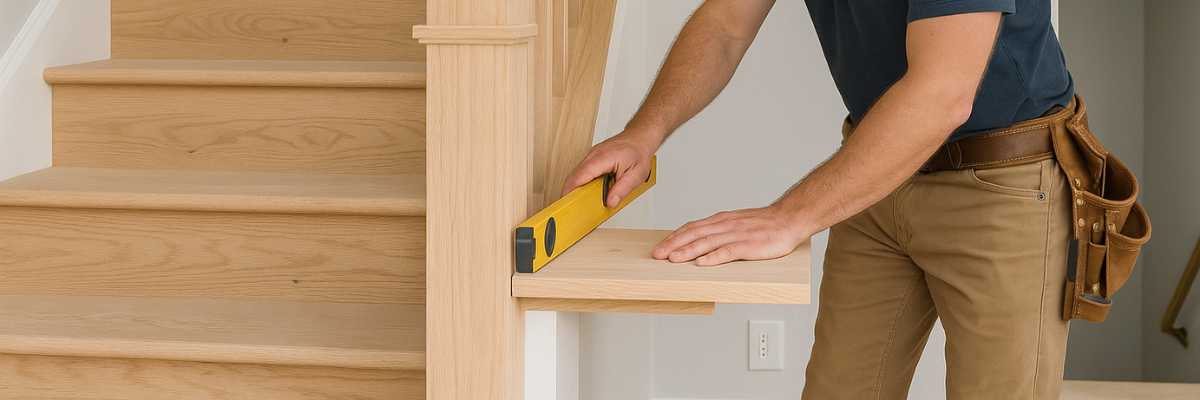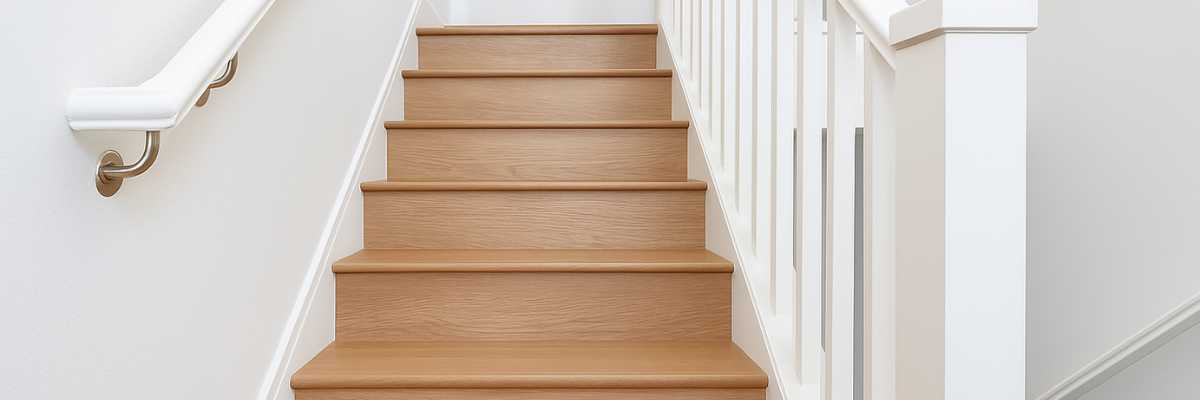Stairways in your home are more than just a functional part of the house; they're also an opportunity to create design elements within one's living space. Be it to improve accessibility by adding a new staircase, matching an existing renovation with a replacement or creating features that add character and style. Here you'll find tips and hints on all aspects of stair construction, from understanding your local build code to selecting the proper materials with each design. These tips will help you tackle your stair-building project with confidence to achieve a safer, better-looking staircase.
Understanding Building Codes And Regulations
Local Codes And Safety Standards:
Requirements differ from city to city, so be sure you are operating on the up and up where you live. These codes are very specific about standards for many different parts of how stairs must be constructed, such as riser height, tread depth and dimensions.
For instance, laws specify the height of each riser (or step) to range from 7 inches to just under 8 inches for folks to safely and comfortably use them. Also, treads, the part you step on to travel up or down stairs generally measure between 10 and 11 inches in depth. Following these measures assists with maintaining uniformity and minimising the chances of hazards.
Handrails are generally required to be a height ranging from 34 inches to as high as 38 inches above any leading tread. Rails, or guardrails along the open sides of stairs created to prevent falls must also be built at high and spaced to meet distance laws guards usually not more than 4 inches from each other.
Permits And Inspections:
Almost all communities require building permits to construct a new stairway, to be sure the work meets safety requirements. The application for a permit requires that detailed plans and specifications be submitted. Once work starts, local officials may inspect at varying points in construction to make sure stairs meet the code and safety standards.
How To Design And Plan Stairs In A Home?
Staircase Architect: When you are considering a staircase, it is not just the style that needs to be decided on. It is all more important than it enters your lifestyle as well as meeting the functional and aesthetic requirements of your home. Think first about how the stairs are primarily used. Are they designed for regular use, to get into a basement or more about aesthetics? So be mindful of which, as this in turn will affect the design options you implement.
Dimension & Configuration: Measure available dimensions in detailed ideas. The steps should be in combination with other components so that they merge well without blocking doors, windows and pathways. Make sure that it has enough headroom and doesn't interfere with furniture or other elements of the room. Proper measurements will tell you the rise and run for your staircase, which are key to both comfortability as well as safety.
Style and Aesthetics: Select a style of stairs that looks great in your home This can be in the form of straight and L-shaped stairs or spiral, floating staircase. Different styles will have their identity and spatial impact. Iron spiral stairs, as an example, can save area while no longer qualifying for excessive traffic areas; but it is also the most famous choice. and floating staircase designs appear modern day yet require some structural preparations to make your home look luxurious helping you optimize space renovating house standing.
How To Calculate Dimensions?
Accurate measurements are crucial for the dimensions.
Rise and Run: A more accurate way of determining rise and run is to measure the overall vertical height, or rise, between one floor and the next, and then divide by the intended riser height to determine the total number of steps. Once the total number of steps has been determined, multiply this number by the tread depth to determine the total run.
Stringer Length: The length of the stringers is provided by the Pythagorean theorem.
How To Choose Materials Wisely?
Choosing the right materials for your staircase is very important, as it determines how long-lasting and stylish they are after all.
Wood: For warmth and versatility, wood is a timeless option. This can be stained & finished in many options to match your home decor as well. Common woods for staircases include oak, maple, and cherry with unique grains and colours that can improve the appearance of your stairs.
Metal: Those who prefer modern style or industrial-themed houses do go for this option. Steel and wrought iron are the most common materials for functional gates because they provide an elegant, sturdy finish with detailed designs. Metal stairs are commonly used in modern spaces for their excellent pure lines and added robustness then another type of material can be worked to combine such as wood, and glass.
Concrete: For a contemporary look or more traditional surround concrete is thick and sturdy. It is very hard-wearing and requires only minimal maintenance which makes it ideal for busy areas. Since concrete stairs are cast in place, they can take virtually any shape and texture that you desire.
Composites: Composites represent a contemporary choice because they focus on the colour and durability of materials. By combining different materials, composites can resemble wood or stones outward and provide more resilience to wear and the environment. It can be a great fit when you want the look but without as high of maintenance and for better wear.
How To Build the Stringers?
Stringers are important stair structural elements, which we will learn below. It is for building stringers the right way that makes your stairs both robust and safe.
Cutting: Create the cutting line from your measurements and cut with a circular saw to make square cuts for stringers. The cut is custom to the exact rise and run of your stairs. The most important thing is to ensure that the cuts are even, and symmetric side-to-side so as not to create an uneven step or a safety hazard. It is important to cut accurately if you want your staircase level and sturdy.
Support: After sawing the stringers they need to be mounted securely just on top of and following a water entrance. Fasten the stringers securely with suitable fasteners and brackets. It makes the stringers able to carry out stairway lots as well as left-yard people. The stairs must be adequately supported to ensure overall stability and safety. Once you get a solid foundation feel free to start fitting up treads and risers but If there is any wobbling or movement make adjustments before moving on.
Install Treads and Risers
With stringers in place, you can put on the treads (the part of the stairs that step is taken) and risers, which is the vertical portion among one tread as well as to the other.
Tread: Attach the stair treads to the stringers using screws or nails. Make sure that they are level and spaced apart equally.
Attaching Risers: Secure the riser to stringers and flush with each side of the outside face.
Add Handrails and Balusters
Not only do handrails and balusters provide a measure of safety, but they also enliven the appearance of stairs.
Guardrails: Guardrails ensure the right height and secure handrails. They are meant to be ongoing and non-scary.
Balusters: Space balusters to code requirements (most likely not more than 4 inches apart) to prevent falls. Attach them to the stairs and handrails.
Finishing Touches
Adding finish to your staircase will not only make it look better but also functional and safe.
Smoothening and Staining: In the case of wooden stairs, sanding is quite an important process for having a smooth and even surface. First, start with coarse-grit sandpaper that will remove all sorts of rough spots or imperfections and then proceed to finer grits for a polished finish. Once the stairs are now smooth, stain or paint them in colours that complement those of your home's decor. Staining reveals the natural grain of the wood and can be done in everything from light to dark shades. Painting allows for a wider range of colours. Seal the wood with a clear finish or polyurethane for wear and tear, and give it a durable, glossy sheen.
Non-Slip Treatment: Safety is always number one, primarily in high-traffic areas. For wooden stairs, consider adding non-slip treads or treatments in addition to relying on the smooth nature of the wood. Non-slip strips or adhesive tread covers can be fixed onto every step, and this might be in forms such as rubber or abrasive coatings. These treatments come in many materials and can be incorporated into the design at minimal appearances to keep aesthetic appeal but add safety.
Lighting: Proper lighting serves two purposes safety and visual appeal. Mount lights that reflect each step to reduce the instances of accidents and to view better. The options are endless: recessed lighting, wall sconces, or LED strips along the stair risers. Installation of motion-sensor lights or timers would go a long way to ensure that the stairs are well-lit at every phase during nighttime or any condition with low light. Adequate lighting will enhance safety and accentuate the beauty of the staircase design.
Safety Considerations
Making sure that your staircase is safe to use daily will be important in daily usage and long-term reliability.
Before you start using your stairs, you have to make sure that all of its components are properly installed. Treads should be firmly connected to the stringers, the risers should be well supported, and the handrails must be suitably anchored. Any movement or wobble in the stairs could suggest loose components, which should be arrested right away to avoid accidents.
Check regularly because regular maintenance keeps your stairs in safe working condition. Periodically check for loose screws, cracked treads, or worn finishes. Immediately address any issues to prevent further damage or safety hazards. Regular inspections may help in identifying the potential problems much earlier, ensuring that your staircase remains serviceable and safe over a considerable period.
Conclusion
Staircase construction is a multidimensional work of art combined with an act of thoughtful design, mastery of the local building code, selection of appropriate materials, and precision of measurement are combined to make it safe, functional, and pleasing to the eye. It would be a staircase that could provide good objectives to your house design by choosing appropriate materials carefully, such as the warmth of wood, sleekness of metal, hardness of concrete, and versatility of composites. The precise construction of stringers establishes stability, and finishing touches such as sanding, staining, and lighting enhance further safety and aesthetics.
Safety should be the top priority throughout the project. Regularly inspect and carefully pay attention to details to prevent any potential issues and keep your staircase secure and reliable for years to come. Finally, a well-designed staircase can be the talking point of your house, serving the purpose of access between levels in the most elegant manner. With these guidelines and paying attention to every smallest detail, you will be assured of undertaking your stair-building project with confidence and eventually enjoying the beautifully crafted and functional addition to your home.







